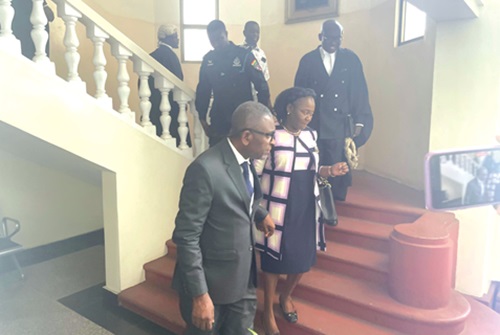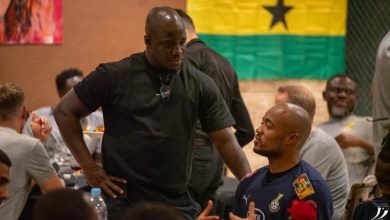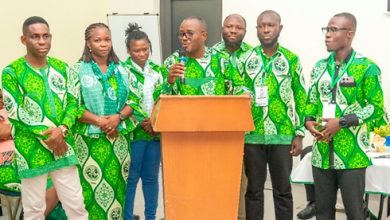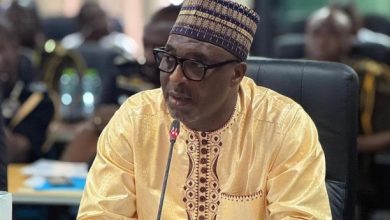Supreme Court dismisses CJ’s injunction application
Chief Justice, Justice Gertrude Sackey Torkornoo failed in her attempt to have her suspension by President Mahama

The Chief Justice, Justice Gertrude Sackey Torkornoo, has failed in her attempt to have her suspension by President John Dramani Mahama halted by the Supreme Court.
In a unanimous decision yesterday, a five-member panel of the apex court dismissed Justice Torkornoo’s application for interlocutory injunction, describing it as ‘without merit’.
The Chief Justice wanted the highest court of the land to put her suspension, as well as the hearing of the three petitions seeking her removal on hold, pending the final determination of her lawsuit challenging the constitutionality of the entire impeachment process against her.
The five-member panel, presided over by the acting Chief Justice, Justice Paul Baffoe-Bonnie, gave the ruling after hearing submissions from a Deputy Attorney-General (A-G), Dr Justice Srem-Sai, and Godfred Yeboah Dame, lawyer for Justice Torkornoo and a former A-G.
Other members of the panel were Justices Issifu Moro Tanko Amadu, Emmanuel Yonny Kulendi, Henry Anthony Kwofie and Richard Adjei-Frimpong.
CJ’s case
Making a case for the application for interlocutory injunction, Mr Dame argued that the prima facie determination against her client violated the law.
He said as of now, no reasons had been given to the Chief Justice regarding the basis for the prima facie determination, nor had the Chief Justice been told whether the prima facie determination was in respect of one or all the three petitions to enable her to adequately prepare her defence.
Such a situation, Mr Dame argued, was a flagrant violation of the rules of natural justice and fair trial guaranteed by the Constitution.
The requirement is not a mere formality or procedural regularity. It is actually a substantive constitutional duty which confers a constitutional right to the Chief Justice.
“The rules of natural justice require that the applicant (Chief Justice) should be told which of the charges contained in the petitions make a case against the Chief Justice and then which of them satisfies the test under Article 146 of the Constitution,” Mr Dame argued.
At that point, Justice Kulendi asked Mr Dame whether a prima facie determination was conclusive.
Mr Dame answered in the negative, but added that the requirement for prima facie determination by the President, in consultation with the Council of State, in relation to an impeachment process of Justices of the Superior Court under Article 146 of the Constitution, was not a mere formality.
“It is actually a substantive constitutional duty which confers a constitutional right to the applicant,” he stated.
The former A-G further stated that if the court took the view that there was no need for a prima facie determination under Article 146 to have basis, including the charges against a person facing impeachment, then the whole judiciary will be endangered.
A-G’s response
In response, Dr Srem-Sai urged the court to dismiss the interlocutory injunction as it was without merit.
The Deputy A-G argued that the matters being canvassed in the application had already been determined recently and dismissed by the Supreme Court in a similar application filed by the Centre for Citizenship, Constitutional and Electoral Systems (CenCES).
“In that particular application, this court heard all the argument that counsel had made and ruled that the issue of prima facie determination was not sufficient ground for granting an interlocutory injunction,” the Deputy A-G said.
Dr Srem-Sai further contended that the entire process adopted by the President regarding the petitions against the Chief Justice was in accordance with Article 146 of the Constitution and therefore no right had been violated.
“What we see here is rather a desire to change the constitutional provision,” the Deputy A-G added.
CJ’s substantive case
On May 21 this year, Justice Torkornoo filed a lawsuit on the basis that the inquiry into three petitions seeking her removal, as well as her suspension by President Mahama, violated the 1992 Constitution.
It was her case that the prima facie determination against her by the President, in consultation with the Council of State, which led to the establishment of the five-member committee to probe the petitions, and her subsequent suspension by the President, was not done in tandem with the Constitution.
She, therefore, sought “a declaration that upon a true and proper interpretation of articles 19(13), 23, 146(1), (2), (4) and (6) and 296 of the Constitution, a determination of a prima facie case in respect of a petition for the removal of a Chief Justice or a Justice of the Superior Court of Judicature is a quasi-judicial process requiring a judicious evaluation, culminating in a reasoned decision”.
Again, Justice Torkornoo prayed the apex court to disqualify the five members on the committee hearing the petitions – Justice Gabriel Pwamang, Justice Samuel Asiedu, Daniel Domelevo, Major Flora Bazwaanura Dalugo and Professor James Sefah Dzisa—as members on the committee, arguing that their membership offended the 1992 Constitution.
he Chief Justice further wanted the Supreme Court to order the committee hearing to be done in public, arguing that the in-camera hearing stipulated by Article 146 (8) can be waived.
Background
So far, four lawsuits and applications for interlocutory injunction have been filed against the suspension of Justice Torkornoo and the impeachment process.
All four applications for interlocutory injunction, including the recent one filed by the Chief Justice herself, have been dismissed by the Supreme Court.
On April 22, the Spokesperson to the President and Minister of Government Communications, Felix Kwakye Ofosu, announced that President Mahama had suspended Justice Torkornoo.
The suspension of the Chief Justice by President Mahama under Article 146 (10) of the Constitution followed the determination of the prima facie case by the President, in consultation with the Council of State, and the subsequent establishment of a five-member committee to inquire into three petitions seeking her removal, in accordance with Article 146 (6) of the 1992 Constitution.



